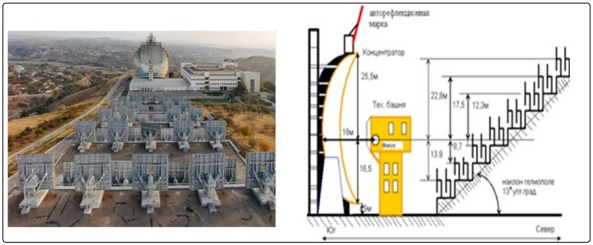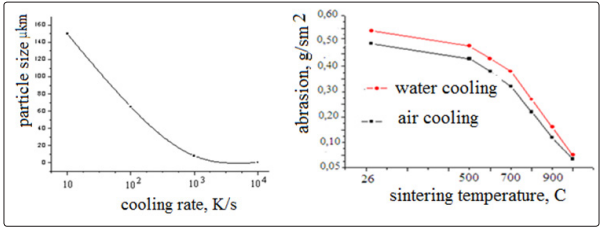Author(s): Paizullakhanov MS*, Kholmatov AA, Sobirov MM, Khamdamov B
The influence of technological modes of the Big Solar Furnace on the process of synthesis of materials from the melt is studied. It is shown that for the synthesis of materials with a set of specified properties, it is necessary to optimize the density and nature of the energy distribution of concentrated solar radiation in accordance with the degree of blackness, absorption coefficient, melting temperature and thermal conductivity of the charge. It is shown that the remelted state and a homogeneous fine-crystalline structure with an optimal combination of crystalline and amorphous phases, which leads to increased wear resistance of the material.
The sun is the main source of energy on Earth, the power of which is incomparable with any other source. The radiation power of the Sun at its zenith near the Earth’s surface is estimated at about 1360 W / m2. A simple calculation shows that to obtain a power of 10 kW, it is necessary to collect solar radiation from an area of 7.5 m2. In the middle lane, at noon in summer, for every square meter oriented perpendicular to the sun’s rays, there is more than 1 kw of solar energy. The main limitations associated with the use of solar energy are caused by its inconstancy: solar installations do not work at night and are ineffective in cloudy weather. However, there is one more circumstance that is especially relevant for northern latitudes - seasonal differences in the length of the day. If for the tropical and equatorial zones the duration of the day and night weakly depends on the season, then already at the middle latitude of Russia, and especially in the circumpolar regions, the shortest day is almost 2.5 times less than the longest.
To increase the efficiency of using solar energy, converting it into heat and electricity, mirror-concentrating systems (MCS) are used. MCS are designed to capture and concentrate the radiation flux to a level that ensures its efficient and economical conversion into energy of the required type. The areas of application of MCS cover thermal, technological and energy aspects. The features of the MCS are determined by the geometry of the concentrator, the requirements for the quality of the mirrors. The following main indicators are characteristic of MCS.

where pref is the reflectivity of the concentrator; Um - the largest opening angle of the paraboloid to the side, deg., (Determined by the upper edge of the paraboloid); E0 - solar radiation density, W/m2 1) The degree of concentration of sunlight in a paraboloid

where D is the diameter of the paraboloid reflector; d is the diameter of the focal spot (taken equal to the size of the smaller semi axis of the focal spot); pref is the reflection coefficient. Optimal values of the degree of concentration typical for solar power plants are in the range from units to hundreds [1]. With the concentration of solar radiation, not only its density increases, but also the distribution in space changes, and, consequently, on the ray-receiving surfaces.
Solar furnaces are widely used to achieve high temperatures including material processing (welding and cladding, surface treatment, coatings and surface hardening and powder metallurgy), synthesis and processing of non-metallic materials (ceramics, fullerenes, carbon nanotubes, aluminate calcium cements and lime production) and metallurgical processes (silicon and aluminum production) [2,3]. As noted in these works, concentrated solar energy can become an alternative in metallurgical processes. However, further research needs to be carried out to consider solar energy processes as an alternative to the well-studied traditional processes. In this work, the effect of concentrated solar radiation of high density on the synthesis of materials of various classes from a melt is studied using the example of pyroxenes CaMgSi2O6 of barium titanate BaTiO3 in order to obtain glass-crystalline materials with high mechanical and dielectric properties.
For the processing and synthesis of materials, the functional and technological capabilities of the Large Solar Furnace (BSF) with a thermal power of 1 MW were used. The technology for processing and synthesizing materials at the BSF provided for irradiation of the material installed on the focal spot with a concentrated high-density solar radiation flux. Irradiation contributed to the heating of the material due to the absorption of the energy of the light quantum.
Heating the material caused its destruction - melting. The melt could be subjected to further irradiation in order to increase its degree of homogeneity and homogenization. The melt could be cooled at different cooling rates. For example, under conditions of spontaneous cooling on the surface of a water-cooled substrate. At the same time, the cooling rate corresponded to 102 deg / s. And under the conditions of pouring the melt into water, the cooling rate corresponded to 103 deg / s. To achieve high cooling rates of the melt, methods of special expansion with copper plates were used, which ensured a cooling rate of about 104 deg / s.

Figure: 1: Large Solar Oven with a thermal power of 1 MW
Figure 2 shows the dependence of the particle size on the cooling rate. As can be seen from Fig. 2, with an increase in the cooling rate of the melt, a decrease in the particle size is observed. Figure 3 shows the dependence of abrasion on the cooling rate. To obtain a quenched material with nanosized particles, it is necessary to cool the melt at a rate above 106 deg / s. The cooling rate of the melt also influenced the wear resistance of the material (Figure 3). The wear resistance of the material obtained by sintering fused basalt rocks at different temperatures increases with an increase in the sintering temperature. When any solid is heated, when a certain temperature is reached, it turns into a liquid. This phenomenon is because with an increase in the temperature of a body, the rate of thermal motion of its molecules increases, and the atoms move away from each other at large distances. As the amplitude of atomic vibrations increases, the destruction of the crystal lattice begins - long-range order disappears - the solid melts.

Figure 2: Particle size versus cooling rate Figure 3: Abrasion versus cooling rate
The melting process takes about 80 s, during which an equilibrium thermodynamic state of the liquid is established. Complete melting of the material is achieved with the values of the concentrated solar radiation flux density corresponding to the optical parameters of the material. Increased flux densities of concentrated solar radiation contribute to an increase in the homogeneity and quality of fused materials [4-7].
Thus, the density and nature of the energy distribution of concentrated solar radiation required for the synthesis of materials from a melt on a BSF corresponds to the optical (absorption coefficient, emissivity) and thermophysical (melting point, thermal conductivity) characteristics of the raw material. The fixation of the amorphous state of the melt during quenching is associated with the cooling rate, which is influenced by such parameters as heat transfer conditions, melt temperature, material of the quenching system, etc
